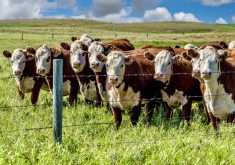A chance to hang out with my granddaughters during New Year’s was celebrated with treats and a movie.
We watched “Clifford the Big Red Dog,” a new film based on the 1963 book of the same name. Clifford and his friend Emily Elizabeth are always on an adventure.
In the movie, Clifford’s size attracts more that just attention. The antagonist owns a company in which they are experimenting on novel ideas to ‘feed the world.’ The big red dog gets the bad guy thinking about magnifying food production, essentially using genes from pets like Clifford for food animals.
Read Also

A great idea for repurposing grain bins
The Morrison family of southern Alberta have transformed old grain bins into unique guest cabins.
This rival already has a laboratory where things have gone terribly wrong: a two-headed goat stares out with his four eyes and cloned sheep (modelled after the world’s first cloned ewe Dolly) are depicted as mentally unstable. The intended message was that genetic experimentation has gone bad, especially for food production animals. I am certain some thoughts lingered in the viewers’ mind as to why they would want the genes of a big red dog in the quest to feed the world.
Millions of young children and their parents have watched the movie and the fact there is a strong and very negative message on food is no surprise. I find this throughout many modern-day books and films. The sinister bad guy is the one somehow tied to growing our food.
- More with Brenda Schoepp: Pitting one farming practice against another benefits no one
For farmers and food producers of all kinds, this messaging takes on importance. Certainly, it is meant to expose or rub those in industrial agriculture and the genetically modified and engineering fields, but the reach extends further than that. It can reflect on the future knowledge of food and food production.
There is great influence through the world of media, every kind of media. And I have often wondered if agriculture should be there too — as agents and advisers to those artistic industries as they search for key social messages.
A cartoon, movie, YouTube, a bestselling book or an interesting Instagram has a far longer reach than a farmer’s or association’s tweet. In the food system there are many stories and, more importantly, a wealth of folks with factual information. They may not however, be trained in the arts.
Think of the negative message in this film in terms of the possible outcomes.
A child is imprinted with the idea that research in the food space is evil. Teenagers are deeply influenced by the entertainment industry and are making food choices for themselves. In the future, they may be unlikely to choose a research field that they feel is ‘just wrong.’ A parent puts into play what they ‘know’ based on the ‘bad guy’ emotion and shifts purchasing decisions while texting that information to their friends.
The role of food production and related research is imperative for our future. The word research in agriculture or food is not limited to microbiology, biochemistry, engineering, toxicology, or epidemiology. Research today is also broad and just as active in climatical, sociological, economic, sensory, nutritional and environmental projects. Who the human actors are and how they respond to food in a society is equally as important research as shelf life or gene splitting.
Buying habits, values and beliefs are influenced and often controlled by emotion and that is what the film and arts industry owns — the emotional response.
If you are hooked on a show, it is likely not for the scenery but for how it makes you feel. Of all the hilarious and lovely parts in this movie featuring that big red dog, it was the evil portrayal of the food research company that stuck with me.
I asked myself if this is a true portrayal of research and what people believe. I was vexed by the implication of using canine genetics to grow human food. My response was emotional.
Could research and communication in agriculture and food drive truth and transparency while carefully crafting an emotional response? Can we get folks to fall in love with a natural ecology again? Will we create excitement for plant breeding using new technology and ancient seeds? How about inspiring curiosity, compassion and the motivation towards a world where ‘all things are possible’ in a fed and educated society in which food is medicine?
Directors hunger for stories with this degree of depth. Embracing the opportunities when they present themselves and encouraging our educated agricultural industry stakeholders to embrace the arts, including the entertainment industry, is central to shifting food production from the antagonist to the protagonist in a story.
It is time for a positive outcome that gives people hope over fear.
Engaging our youth to set the stage with their social navigation tools and their talent to lead in research or to tell the story through the arts and to create a following is the task that lies ahead.
Let the show begin!
















